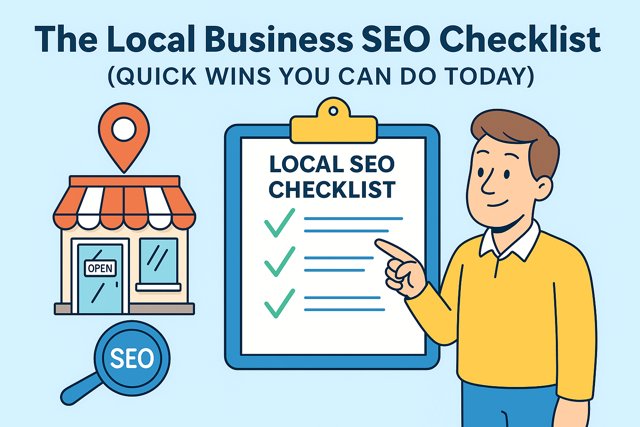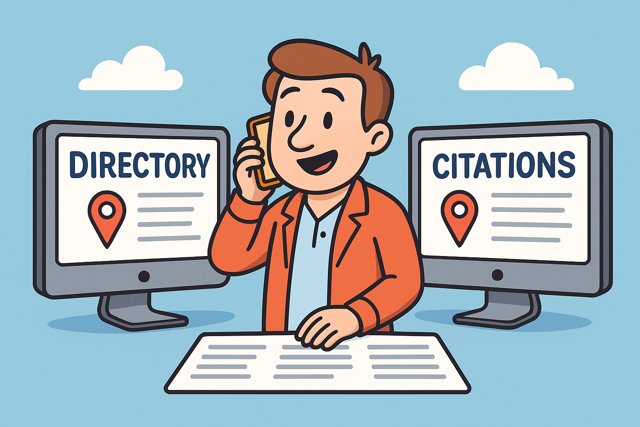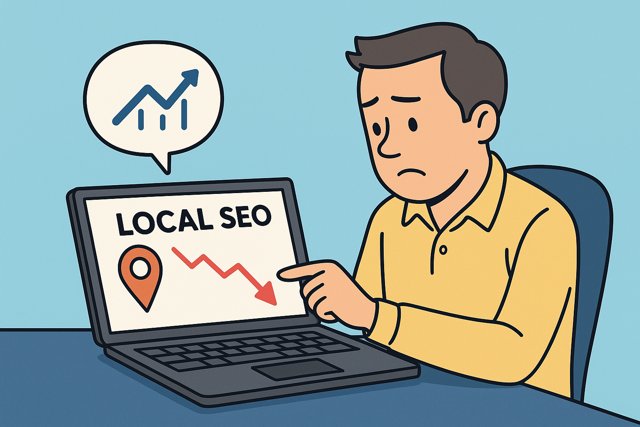
Running a local business means your customers are just around the corner — but only if they can find you online. With more people searching “near me” than ever before, local business SEO is your secret weapon to stand out in the crowd. No complicated jargon, no wasted budgets. Just simple, effective steps you can take today to get noticed by Google and reel in those local customers.
Here’s your local business SEO checklist — all the quick wins Darren wishes he knew before losing half his foot traffic to that shiny new café down the street.
1. Claim and Optimize Your Google Business Profile
Google Business Profile (formerly Google My Business) is the heart of local SEO. It’s the box that shows your business info, photos, reviews, and hours right in Google Search and Maps.
Quick Wins:
- Claim your profile if you haven’t.
- Complete every field: address, phone, hours, website, categories.
- Use your exact business name consistently.
- Add high-quality photos (inside and out).
- Write a clear, compelling business description with local keywords.
Why Darren Failed Here:
Darren listed his business as “Darren’s Shop” once and never updated it. Meanwhile, his competitor “Darren’s Fishing Tackle” claimed and optimized their profile, stealing all the local Google love.
Pro Tip:
Update your profile regularly with posts about offers, new products, or events to keep Google and customers engaged.
2. Consistent NAP (Name, Address, Phone Number) Everywhere
Google needs to trust your business details are accurate and consistent across the web. That means your NAP should look exactly the same on your website, directories, social profiles, and anywhere else.

Quick Wins:
- Check your website footer and contact page.
- Use tools like Moz Local or Whitespark to find inconsistent listings.
- Fix duplicates or conflicting info on major directories (Yelp, Yell, Bing Places).
Pro Tip:
Use the same formatting everywhere — abbreviations or not — for example, “Street” vs “St.” can confuse Google.
3. Local Keyword Research — Speak Your Customers’ Language
People searching for local businesses don’t type like robots. They search for “best pizza near me,” “car mechanic in Bristol,” or “24-hour locksmith London.”
Quick Wins:
- Use Google Autocomplete and “People also ask” for ideas.
- Focus on long-tail keywords with local intent.
- Sprinkle them naturally into your homepage, service pages, titles, and meta descriptions.
Darren discovered that adding “in Chester” to his product pages brought more local buyers than just “fishing rods.”
Pro Tip:
Don’t forget to include local landmarks or neighbourhood names if relevant. People search for “cafes near Chester Cathedral” too.
4. Optimize Your Website for Local SEO
Your website needs to send strong local signals to Google.
Quick Wins:
- Include your city or neighborhood in key places: title tags, headings, meta descriptions.
- Add a dedicated Contact page with a map embed.
- Create local landing pages if you serve multiple areas (e.g., “Plumbers in Manchester,” “Electricians in Salford”).
- Ensure your site loads fast and works well on mobile.
Darren learned the hard way — having a one-page site just called “Darren’s Fishing” wasn’t enough for Google to know he covered Chester, Liverpool, and Manchester.
Pro Tip:
Add a “Locations We Serve” section with clickable links to local pages. Helps users and search engines.
5. Get and Manage Local Reviews Like a Pro
Reviews don’t just build trust — they impact rankings. Google favors businesses with fresh, positive reviews and active engagement.
Quick Wins:
- Ask happy customers for reviews on Google.
- Respond promptly to every review (thank good ones, handle bad ones professionally).
- Feature testimonials on your site.
- Use tools like Grade.us or Podium to automate review requests.
Darren’s review count was zero until he started asking politely — now his business shines brighter than the local fish and chip shop.
Pro Tip:
Add a review widget to your website and link to your Google review page in email signatures.

6. Build Local Citations and Directory Listings
Local citations are mentions of your business on other sites — even without links. They help Google verify your location and legitimacy.
Quick Wins:
- Submit your NAP to relevant directories (industry-specific and general).
- Avoid low-quality or spammy directories.
- Check citation accuracy regularly to prevent misinformation.
Darren’s mistake was ignoring citations outside of Google — missed out on key local directories like FreeIndex and Yell.
Pro Tip:
Keep a spreadsheet of where your business is listed to track and update info easily.
7. Use Local Structured Data Markup (Schema)
Adding schema markup tells search engines exactly what your business is — its type, address, phone, hours, reviews, and more.
Quick Wins:
- Use plugins like Schema Pro or Yoast SEO if you’re on WordPress.
- Test your markup with Google’s Rich Results Test.
- Add schema for events, products, FAQs if relevant.
This little coding boost helped Darren’s product pages get rich snippets showing stars and prices, attracting more clicks.
Pro Tip:
Use LocalBusiness schema to confirm your location info to Google.
8. Create Local Content That Connects
Local content helps you connect with your community and rank for local searches.
Quick Wins:
- Write blog posts about local events, news, or partnerships.
- Share customer stories or case studies with local flavour.
- Create guides like “Top Fishing Spots in Chester” or “How to Choose a Locksmith in Manchester.”
Darren started a “Chester Fishing Report” blog series — traffic went up, and locals started sharing his site like a trophy catch.
Pro Tip:
Collaborate with other local businesses for guest posts and cross-promotion.
9. Optimize for Voice Search
More people are using voice assistants to find local businesses.
Quick Wins:
- Use natural, question-based keywords: “Where is the nearest plumbing service?”
- Add an FAQ section answering common local queries.
- Keep answers concise and conversational.
Voice search helped Darren snag last-minute customers who spoke “Find nearest tackle shop open now.”
Pro Tip:
Include “near me” and time-sensitive phrases (“open now”) in your content.
10. Monitor Your Local SEO Performance
You can’t improve what you don’t measure.

Quick Wins:
- Use Google Search Console to track local keyword rankings.
- Set up Google Analytics goals for contact form submissions or calls.
- Monitor your Google Business Profile insights for customer actions.
Darren ignored this for years — then he realized he could see which pages and keywords actually brought customers.
Pro Tip:
Use call tracking numbers to measure phone leads’ source.
11. Harness Social Media for Local Engagement
Social signals don’t directly boost SEO, but local social media activity can drive traffic and brand awareness.
Quick Wins:
- Post regularly about local events, offers, and stories.
- Engage with local groups on Facebook, Nextdoor, and Instagram.
- Encourage customers to tag you and share experiences.
Darren’s Facebook page was mostly crickets until he posted about the local fishing competition — then shares, comments, and foot traffic jumped.
Pro Tip:
Use location hashtags (#ChesterFishing) to increase local reach.
Final Thoughts: Your Local SEO Journey Starts Now
Local SEO isn’t rocket science — it’s about being found where it matters most. By ticking off these checklist items, Darren turned his floundering business into a local champion.
Don’t wait until your competitors gobble your customers. Claim your Google Business Profile, get your NAP consistent, and start chatting like a local. Keep your site speedy, mobile-friendly, and packed with useful, locally relevant content. Manage your reviews like gold and watch your leads multiply.
Remember, SEO is a marathon, not a sprint. Darren’s still learning, but every step forward counts. Now it’s your turn — get started today, and reel in those local customers before Darren steals ’em all back!
Leave a Reply